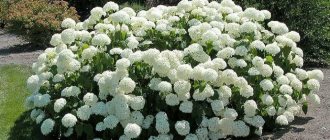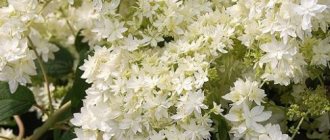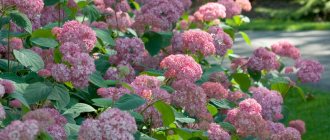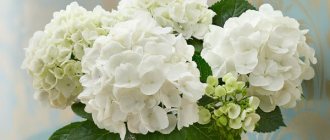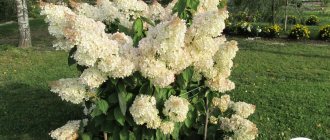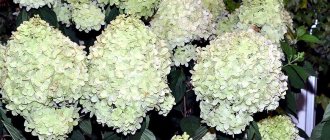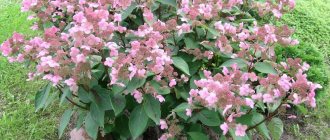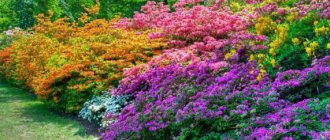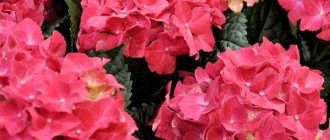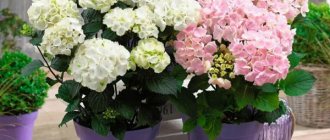Author: Elena N. https://floristics.info/ru/index.php?option=com_contact&view=contact&id=19 Category: Garden plants Published: February 17, 2019Last edits: April 23, 2021
- Growing conditions
- Dividing the bush
Tree hydrangea (lat. Hydrangea arborescens) is a species of plants of the genus Hydrangea of the Hydrangeaceae family, found in the wild in eastern North America. This is the most unpretentious and widespread species of the genus, which can easily withstand severe winter frosts.
Description
Tree hydrangea (Hydrangéa arboréscens) belongs to the Hydrangeaceae family. North America is considered the birthplace of the plant. The natural habitat is the rocky mountains and river banks of Indiana, New York, and Oklahoma. Found naturally in China and India. Hydrangea was brought to Europe at the beginning of the 19th century by the German naturalist Philip Franz von Siebold. The cultivated shrub can now be seen in any country in the world.
Experts use another botanical name for the plant - hydrangia, which is translated from Greek as “a vessel with water”. And this is no coincidence, since the shrub is quite moisture-loving. In Japan, the culture is called “longing for water”; in eastern countries it is called “fashionista”: due to the changing shades of colors (white, greenish, pink). In the language of flowers, hydrangea means “remember me.” She was assigned such qualities as sincerity, hope, modesty.
The deciduous shrub reaches an average height of 1.5 meters, in nature – up to 3 meters. Thin tubular shoots are slightly pubescent. The voluminous, ovoid leaves have a rich green color that lasts until cold weather. In some species, shoots acquire a reddish tint by August. The length of the leaf blades is about 20 cm. The leaves on thin, long petioles are located on the branches opposite each other (opposite).
Hydrangea blooms profusely and luxuriantly from June to October. Large caps of inflorescences, reaching a diameter of 15-30 cm, consist of many flowers, which are smaller in the center than at the edges. The maximum diameter of one bud is 3 cm. Depending on the variety, the color of the petals may vary. Densely arranged inflorescences often cover the bush completely, as if a cloud had landed. By the end of October, seeds ripen on the plant.
Tree hydrangea is quite cold-resistant. It grows quickly: shoots grow thirty centimeters per season.
There are many legends and beliefs associated with the plant. One of them says that on Buddha’s birthday, flowers rained from the sky, and then a wonderful nectar called “amicha” poured down. Suddenly, a flowering shrub called “aujisai” appeared, which is what the Japanese call hydrangea.
Another Japanese legend says that a guilty emperor gave his beloved’s family a bouquet of hydrangeas to make amends. Since then, the flower has symbolized the sincerity of feelings. Although in some countries, a gift of hydrangea means love suffering and loneliness.
If we talk about signs, then an ornamental shrub growing in a garden plot will keep the owner from doing bad things and help overcome bad habits: alcohol, smoking; will give peace of mind and good health.
Rating of the best varieties of hydrangeas
| Nomination | Place | Name | Rating |
| The best varieties of paniculate hydrangeas | 1 | Grandiflora | 5.0 |
| 2 | Polar Beer | 4.9 | |
| 3 | Phantom | 4.8 | |
| 4 | Limelight | 4.7 | |
| 5 | Vanilla Fraze - 5th place | 4.6 | |
| 6 | Pinky Winky - 6th place | 4.5 | |
| The best varieties of tree hydrangeas | 1 | Annabelle | 5.0 |
| 2 | Diamond Rouge | 4.9 | |
| 3 | Grandiflora | 4.8 | |
| 4 | Sterilis | 4.7 | |
| 5 | Pink Bella Anna | 4.6 | |
| 6 | White House | 4.5 | |
| The best varieties of large-leaved hydrangeas | 1 | Nico Blue | 5.0 |
| 2 | Endless Samme | 4.9 | |
| 3 | Alpenglüchen | 4.8 | |
| 4 | Schneeball | 4.7 | |
| 5 | Peppermint | 4.6 | |
| 6 | Cotton Candy - 6th place | 4.5 | |
| The best varieties of oakleaf hydrangeas | 1 | Snowflake | 5.0 |
| 2 | The Snow Queen | 4.9 |
Types and varieties
At the beginning of the twentieth century, the selection of tree hydrangea began. Today, breeders have bred about 70 varieties of the plant. Scientists continue to work on obtaining new unusual shades, double flowers and original leaf shapes. Now there are more than a hundred varieties of hydrangea. Winter-hardy varieties are popular, making it possible to grow ornamental shrubs in the Moscow region and Russian regions with a cold, changeable climate.
Annabelle
The popular variety attracts the eye with large snow-white inflorescences, the diameter of which is about 20 cm. Under the weight of the inflorescences, the branches can bend towards the ground. Long flowering: June – September.
An adult shrub reaches 1.5 meters in height and grows up to 3 meters in width. The color of the leaves lasts until autumn. The Annabelle variety tolerates severe frosts (down to -40-50 degrees) and is suitable for growing in unfavorable climatic regions. It is more difficult for a plant to survive drought than cold, so hydrangea needs regular and timely watering. In one place, this garden crop can grow for 40-50 years, continuing to delight every year with magnificent “caps” of white flowers. The shade of the buds can be changed by watering the plant with a special solution.
Grandiflora
Hydrangea of this variety is recommended to be grown in regions with milder climates, since the root system is not as resistant to extremely low temperatures as that of Annabelle. The plant grows quickly, shoot growth reaches 25 cm per year. The size of an adult bush ranges from 1.5 to 2 meters in height, and grows no more than 3 meters in width.
Large leaves of bright green color. Umbrella inflorescences change color several times during flowering: the blooming flowers of a soft green hue acquire a snow-white color. Towards the end of flowering they become creamy and yellow in color. The flowering period is long - from June to September.
The variety is resistant to drought and pests. In rainy weather, watering should be avoided to avoid fungal infections.
Sterilis
Hydrangea is characterized by rapid growth, reaching a maximum height of about 2 m, width - 2.5 m. Flowering lasts 4 months, starting in June. The greenish-tinged flower petals become snow-white as they bloom. The heart-shaped leaves are 15 cm long. The plant is resistant to temperature changes and needs shelter for the winter. Does not like to grow in windy areas.
Pink Annabelle
The variety was bred on the basis of "Annabelle". The peculiarity of the tree-like shrub is the flowers are dark pink in color. Lush inflorescences look like a pyramid, reach a diameter of 30 cm. Elastic shoots are resistant to strong winds and heavy rains, and do not bend under the weight of flowers. The oval green leaves have a glossy shine, turn yellow and fall off in the fall.
Incrediball
This variety of hydrangea is distinguished by the large size of its inflorescences, the diameter of which reaches 30 cm. The branches of the plant are erect and powerful. They easily hold heavy inflorescences. The color of the petals changes from soft green to snow-white. The average height of an adult shrub is 1.5 meters. Bad weather is not scary for hydrangea: it easily tolerates drought and frost, precipitation and wind, and every year continues to surprise with its abundant flowering.
Sweet Annabel
The height and width of the shrub reaches 1.2 m. Red-pink inflorescences bloom on strong shoots in June. During long flowering, the color of the petals becomes pale, and by autumn it acquires a greenish tint.
Hayes Starburst
The dome-shaped inflorescences of hydrangea consist of many double white star flowers. The variety has a long flowering period: from June until frost. The bright green leaves retain their shade until autumn. The shrub does not exceed a height of 1.2 meters. Strong branches can withstand the load during flowering and do not bend.
Hydrangea "Golden Annabelle"
Hydrangea "Golden Annabelle" or "Golden Annabelle" is a new variety released in 2022 and has become a real gift for hydrangea lovers. Tree hydrangea is a plant with a long flowering period and very beautiful inflorescences, but its foliage previously did not represent any decorative interest. With the advent of the Golden Annabelle variety, the situation changed for the better.
This cultivar is generally similar to its older sister, the common hydrangea “Annabelle”. 'Golden Annabelle' also blooms from July to September in huge clusters of flowers that vary in color from lime green to creamy white. Its main difference from its sister lies in the fact that it has golden-yellow foliage sitting on strong stems. Therefore, this plant has a high decorative value even outside the flowering period.
“Golden Anabel” is a medium-growing variety up to 130 cm in height and 100 cm in width. Place this deciduous shrub in the sun or partial shade in neutral soil. "Golden Annabelle" is hardy and unpretentious, just like the classic "Annabelle". In spring it is better to cut its shoots short, and it will bloom profusely from July to September.
Hydrangea 'Golden Annabelle'. © floraplanet
Features of cultivation and care
Before growing tree hydrangea, you need to familiarize yourself with the features of caring for the plant. By following the simple rules of agricultural technology, the ornamental shrub will delight you with abundant flowering every year.
Soil selection
It is not recommended to plant hydrangea in alkaline soil. The shrub will grow well on slightly acidic and acidic loams. A small amount of lime will not harm the plant. You can acidify the soil substrate using sawdust, peat and pine bark. This must be done 6 months before planting the crop.
Location and lighting
Ornamental shrubs should be planted immediately in a permanent place, since frequent transplants are not recommended. Hydrangea takes a long time to adapt to a new area.
Experts advise when choosing a location to consider the following features:
- abundant, diffuse lighting. The scorching rays of the sun should be avoided. Otherwise, the petals of the inflorescences will lose their original color - they will “burn out”, and the flowering period of the hydrangea will decrease by 3-5 weeks. It is also better not to plant in the shade. With a lack of sunlight, the inflorescences and petals become smaller;
- protection from wind and draft. When there are gusts of wind, shoots with heavy inflorescences may bend towards the ground, which will change the shape of the bush: it will not look so attractive;
- sufficient area for growth. The distance from neighboring shrubs and trees should not be less than two meters so that they do not shade the hydrangea and take moisture from the soil.
Hydrangeas will grow comfortably near various garden fences. In the first half of the day, the plant will receive abundant lighting; from lunchtime, the fence will protect it from the scorching rays of the sun. In addition, such a place looks impressive from the point of view of landscape design.
Temperature, humidity, watering
Proper watering of tree hydrangea is one of the important rules in caring for shrubs. If there is a lack of moisture, the plant can “throw off” its inflorescences; if there is too much, it can cause rotting of the root system.
Watering should be carried out depending on the weather: when dry - 1 or 2 times a week, when rainy - exclude during precipitation. Hydrangea should be watered with soft, settled water, the temperature of which should not be lower than +20 degrees.
Fertilizers and fertilizers
It is recommended to feed hydrangea in several stages:
- The first feeding is carried out 2 weeks after planting. Feed with the following composition: urea (20 g), potassium (30 g), superphosphate (40 g). This mixture is added annually in early spring;
- the second feeding is carried out before flowering. You can use ready-made Kemira-flower fertilizer, or you can independently prepare a mixture of superphosphate and potassium in proportions of 50:40. You should not add a lot of nitrogen, otherwise the flower petals will turn greenish;
- The final feeding at the end of summer will be the application of rotted manure: 15 kg per 1 sq.m.
Fertilizers cannot be applied in the fall, since the branches need to have time to become woody by winter.
To strengthen the branches, you can water the bush with a weak manganese solution.
Transfer
Hydrangea is replanted in spring or autumn. Replanting should not be done during the summer months. During flowering, it is difficult for the plant to adapt to a new place. The inflorescences will fall off and may not appear again even next year.
The most favorable time for transplantation is spring. It is important to carry out this procedure before the buds open.
In autumn, the shrub is replanted after flowering; it is advisable to do this at the end of September. Hydrangea will have time to “get comfortable” in the new place before the onset of frost and spend the winter safely.
Transplant rules:
- dig up a bush with a lump of earth, trying not to damage the roots;
- before or after planting, hydrangea is pruned, shortening the shoots by a third of the length;
- the transplanted hydrangea is watered abundantly;
- within 2-3 weeks after transplantation, the shrub needs to be shaded from the bright rays of the sun;
- fertilizing is carried out after a month, when active growth of shoots begins. This means that the hydrangea has successfully taken root.
Preparing for winter and caring for winter
Varietal hydrangea has good winter hardiness, which allows it to be grown in regions with harsh climates. Even if the plant is damaged by frost, it grows back and blooms.
Faded inflorescences and new shoots must be removed in the fall: young shoots may not tolerate frost. Experienced gardeners, wanting to grow a short bush, often cut off all the branches, leaving 2-3 buds on each. In spring new shoots appear. Hydrangea is thus rejuvenated.
Annual and biennial plants need shelter for the winter. Covering material or spruce branches will protect the hydrangea from frost. You can build a wooden fence around the bush, which will trap snow.
It is advisable to hill up a mature shrub well for the winter and sprinkle the soil around the leaves with yellowed leaves to protect the roots from frost.
Planting a plant in open ground
Choosing a place and time of landing
Tree hydrangea is a fairly unpretentious crop, but in relation to it, it also requires compliance with certain requirements for the choice of location and time for planting.
These include:
- Optimal lighting mode. Direct sunlight slows down the growth of plants, causing the inflorescences to shrink and become more faded in color. In the shadows, the culture suffers and languishes. Therefore, diffused lighting is preferable for hydrangea, excluding the rays of the midday sun.
- Protection from drafts and wind. A favorable place is near various fences of the site.
- Sufficient area for growth; the absence of neighboring tall crops that provide strong shading.
- Distance from soil water (at least 1.5 m). Low-lying areas where stagnant processes are possible are also unacceptable.
- There are no plantings with a shallow root system within a radius of 2 m to ensure plant access to moisture and nutrients.
Hydrangea does not like alkaline soils. If the selected area does not match the acidity, then you can pour it with citric acid (2 tablespoons per 10 liters of water) or add peat (1.5 kg per 1 m2). And to maintain the required level of acidity, the soil should be watered regularly (once every 2 weeks) with acidified water.
It is better to plant tree hydrangea in open ground in the spring, so that it has time to take root and develop before winter. In the southern regions, the procedure can be carried out in early autumn.
Soil preparation
Tree hydrangea is, in principle, unpretentious to the soil; it can grow in any soil. However, for abundant flowering and unique beauty of inflorescences, the plant needs land with special characteristics. Soil requirements:
- loose, with good air and water permeability;
- the optimal composition is leaf soil, rotted humus, peat and coarse river sand in the proportion: 2:2:1:1;
- neutral or slightly acidic soil.
- Loamy areas with an average acidity level are acceptable.
Dimensions: the depth, length and width of the planting hole depend on the size of the root system of the seedling and on average range from 50 to 70 cm. The day before planting, 1-2 buckets of water are poured into the hole to saturate the soil. A drainage layer (broken brick or expanded clay) up to 7-8 cm is laid on the bottom. A good way to retain moisture in the soil is to use hydrogel in small quantities.
Additionally mineral fertilizers per plant:
- superphosphate - 65 g;
- potassium sulfate - 25 g;
- urea - 25 g.
Depending on the varietal specifics (compact or spreading bush), as well as the purpose of planting, the distance between planted crops should be from 1.5 to 2.5 m.
When planting, it is important that the root system is flush with the ground, even slightly translucent. Then the soil is compacted, watered abundantly and covered with a mulch layer. For this purpose, it is good to use peat, bark, straw, sawdust and other similar materials. In the future, this will be an effective way to control weeds and conserve moisture.
Pruning in spring
Tree hydrangeas are pruned in the spring before the buds open.
The procedure has three goals:
- rejuvenating: branches are left no higher than half a meter from the ground. Such a plant will bloom only next year;
- formative: to give a decorative appearance to the shrub. So that the plant does not thicken and the flowering is abundant, strong shoots are shortened by 3-5 buds, weak shoots are reduced by 2 buds. After this type of pruning, the hydrangea must be fed with nitrogen, potassium and phosphorus;
- sanitary: remove broken, dried, undeveloped shoots after winter.
Young tree-like hydrangeas are not pruned until they are four years old.
Tree hydrangeas - photo
Although tree hydrangea is not as diverse as its paniculate counterparts, it is still very impressive and beautiful! Not only experienced gardeners, but also amateur beginners can cope with it. If you still have doubts, take a look at our photo selection!
Photo: otrada-o.ru
Photo: fermoved.ru
Photo: flowerbank.ru
Photo: liveinternet.ru
Photo: sadoviycentr.ru
Photo: green38.ru
Photo: dev.lorberg.com
Photo: oir.mobi
Photo: archiwum.allegro.pl
Photo: luchshii-sad.ru
Photo: alexandrovosad.ru
Photo: wyomingplantcompany.com
Photo: oir.mobi
Photo: oir.mobi
Photo: sad-fialok.ru
Photo: oir.mobi Photo: hu.pinterest.com
Photo: passionhemerocalles.blogspot.com
Photo: distano.ru
Photo: sadko-plant.ru
Photo: flo.discus-club.ru
Photo: oir.mobi
Photo: oir.mobi
Photo: smak.ua
Photo: marusin-sad.com
Paniculata hydrangea: the best varieties for the Moscow region
Reproduction methods
Hydrangea can be propagated in three ways.
Green cuttings
Cuttings are cut in early June with 2-3 pairs of leaves. Half of the leaf blade is cut off. Cut shoots are placed in a root growth stimulator for 5 minutes. The cuttings are planted in a greenhouse or in a bed with light nutritious soil. They shade. The lower paired buds are deepened into the soil to the middle of the internode.
After 20-30 days, the cuttings will take root. Throughout this period, it is necessary to maintain high humidity by covering the cutting with a cut plastic bottle.
By layering
In spring, the shoot is carefully bent to the soil, placed in a shallow groove, sprinkled with a 2 cm thick layer of soil substrate, and pinned. There is no need to sprinkle the tip of the shoot; bend it slightly upward.
The soil must be kept moist throughout the season. In summer and autumn the soil needs to be topped up. Next spring, the rooted shoot is separated from the adult bush with pruning shears. It is planted in fertile soil in a shaded area for growing.
Tree hydrangea grown from layering or cuttings can be planted in a permanent place after a year or two. The young shrub will bloom in the 4th year.
Dividing the bush
Hydrangea is dug up and divided using pruning shears or a sharp shovel. New parts of the plant are planted in a hole that is prepared in advance. Then the branches are cut off. The divided hydrangea takes root well.
Landscaping Tips
This ornamental shrub can be combined with many types of crops. Here you should take into account both the location of the flower garden and the characteristics of the site.
In sunny places, together with tree hydrangea, spirea, mock orange, and lilac will feel great. Hydrangea looks very harmonious near a pond, filling the space and becoming the main compositional element. Together with it, hosta and astilbe will take root near the water and complement the appearance.
Hydrangea in landscape design
You don’t have to be afraid to plant this species near fruit trees. A fruit tree will not harm the ornamental shrub in any way, but the second one will only add volume and attractiveness to the entire garden.
Tree hydrangea is an amazing and incredibly attractive shrub that can enliven any area with its appearance.
0 0 votes
Article rating
Possible problems
The hydrangea has wilted: the plant lacks moisture. This may also happen due to excessively high air temperatures.
The leaves have turned yellow: old leaf blades turn yellow due to waterlogging, young ones - due to excessively hard irrigation water. Watering should be done with moderately soft water, depending on the weather.
The color of the inflorescences has changed: this means that the acidity of the soil has changed.
The flowers have faded: one of the reasons is that the hydrangea is constantly exposed to direct sunlight. The shrub needs to be shaded at noon.
Slow growth, poor flowering: the wrong place for growing. The plant is in the shade all day and lacks sunlight.
Diseases and pests
Proper care is the key to healthy hydrangea. High humidity and low temperatures can cause fungal infections that affect leaves and flowers. Such diseases include powdery mildew, septoria, rust, downy mildew, gray and white rot. For preventive purposes, it is recommended to treat hydrangea tree with Bordeaux mixture. A diseased plant is treated with specialized fungicidal agents.
Sometimes hydrangea is affected by insect pests: aphids, slugs, spider mites, nematodes. With a small lesion, you can try to destroy the parasites using folk remedies. To do this, prepare a garlic or tobacco solution (100 g per 5 liters of water), leave it for 2 days. Before spraying, add a small amount of soap to the solution so that the infusion adheres well to the leaves.
In case of significant damage, you will have to use the appropriate insecticides - “Aktellik”, “Aktara”, “Fitoverm” and others.
The best varieties of paniculate hydrangeas
Panicle shrubs look more like trees. They are distinguished by dark green leaves and burgundy buds. This is a frost-resistant type that survives the winter without covering material. Hydrangeas grow quite tall (up to 5 meters).
Grandiflora
Rating: 4.9
This species is not too whimsical, but it is important to follow the basic rules of care in order to get a lush plant. The bush reaches three meters in height. White flowers delight the eye for three months from the beginning of June. The lifespan is more than 35 years. The bushes can withstand frosts up to thirty degrees below zero. Some gardeners still insulate the plant using fallen leaves and slate. Most often, Grandiflora is affected by insects and ashtray. Insecticides are used to combat them. The plant does well in a dark area and under drought conditions.
Advantages
- high growth of the bush;
- longevity of life;
- abundant and rich flowering;
- good frost resistance.
Flaws
- the need for soil acidity;
- flowers do not bear fruit.
